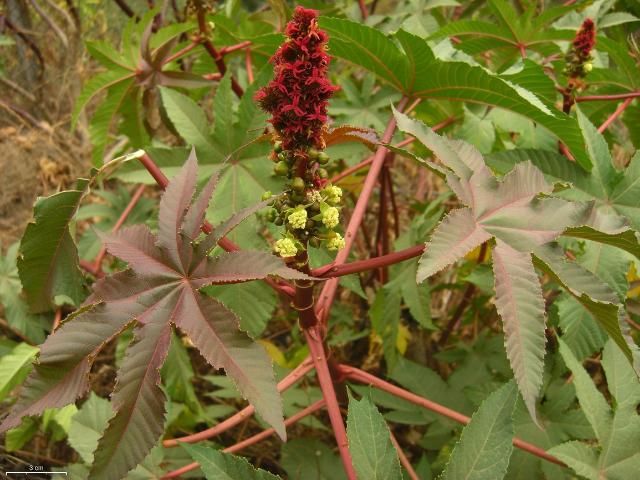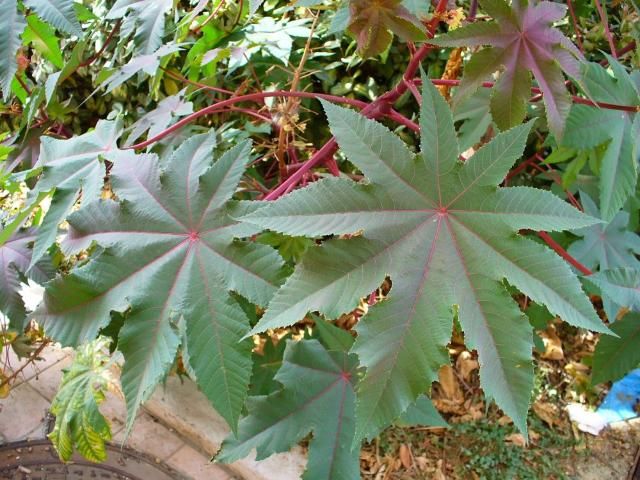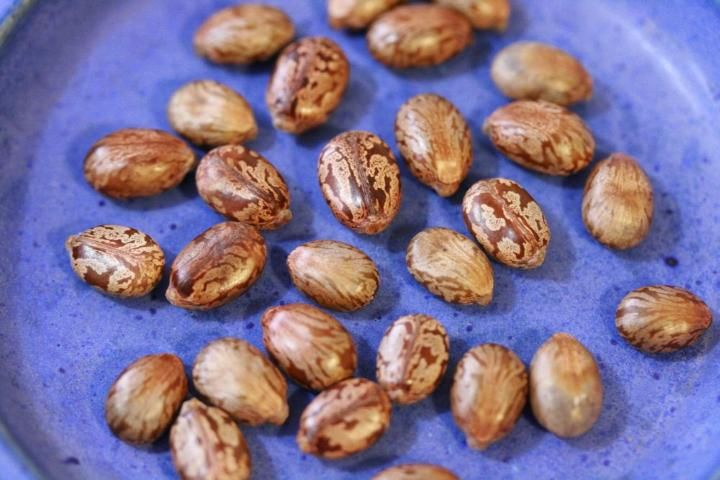Family
Euphorbiaceae, spurge family.
Genus
Ricinus is a Latin term for "a kind of tick," and it refers to the resemblance of castor bean seeds to dog ticks.
Species
The species name communis comes from the Latin word commun, and simply means "common."
Common Names
Castor Bean, Castor-Oil Plant, Palma Christi, Wonder Tree
Explanations of these common names are not known.
Description
This small-statured tree comes from northeastern Africa and the Middle East. It is non-native to Florida and considered a Category II invasive species by the Florida Invasive Species Council because it is abundant throughout Florida but has not yet displaced native plant communities. This fast-growing plant is found throughout tropical and subtropical climates on disturbed sites such as edges of roads, old fields, and rocky slopes. Castor bean grows best in full sun and can reach heights of up to 40 feet where frost is not present. In colder climates where temperatures drop below freezing, castor bean functions like an annual plant and only reaches heights of 15 feet. Leaves are simple and alternate and can grow very large; from 15 to 30 inches wide. The green to reddish leaves are lopsidedly peltate, with the petiole attaching to the interior of the blade above the center point. Each leaf has 5 to 11 major veins radiating outward into narrow lobes with jagged margins. In warmer climates, the semi-woody trunk can reach a foot in diameter, whereas in colder climates the plant remains herbaceous and exhibits slower growing habits. Flowers appear in summer and fall on tall spikes up to 18 inches long that grow out of the top of the stems. Male and female flowers appear on the same spike, with the yellow male flowers pollinating the red female flowers. The fruit is a ½- to 1-inch diameter, spiny capsule that turns from yellow to blue-green and then to brown as it matures. Each capsule houses three small, poisonous seeds that resemble dog ticks.

Credit: Jason Hollinger, CC BY 2.0

Credit: pizzodisevo, slowly i will recover, CC BY-SA 2.0
Allergen
Castor bean is considered to be extremely allergenic. Its large production of pollen can cause severe allergies such as asthma. Contact with the sap, flowers, leaves, or seeds has been known to cause skin rashes. Warning: the mottled seeds contain a highly poisonous agent called "ricin" that, if inhaled or ingested, can kill animals and humans.

Credit: dogtooth77, CC BY-NC-SA 2.0
Storm Tolerance
This shrub or small tree is not very wind resistant and can be blown over in relatively mild wind events.
Applications
Commercial/Practical
Castor oil is a non-toxic vegetable oil extracted from the seeds of this plant. It is used as an agent in fabric coatings, paints and varnishes, inks, waxes and crayons, dyes, and ointments. Ricinoleic acid, a derivative of the poisonous protein "ricin" that is found in the seeds, has been used in spermicidal lubricants, cosmetics, and anti-fungal compounds. Crushed seeds can be used as a high-nitrogen fertilizer and they are safe to use as a livestock feed when put through a detoxifying process. In addition, the stems of this small tree are used to make wallboard and paper products.
Horticultural
Castor bean can grow very fast, becoming tree-like in 3 to 4 months! In warmer conditions, seeds will germinate regularly, a trait that makes the plant a major nuisance in Florida. Castor bean has not been available in Florida nurseries since 2001 when members of the Florida Nursery Grower's Association voted unanimously to discontinue its sale.
Medicinal
The castor bean has been used in folk remedies for a variety of reasons. Some examples include its use to expel worms or parasites from the intestines, and as a purging agent, expectorant, antibacterial agent, insecticide, and tonic. Today, castor oil is used as a laxative and as a topical agent to treat dermatitis, ringworm, and warts.
References
Borror, D. J. 1988. Dictionary of root words and combining forms (1st ed.). Mountain View, CA: Mayfield Publishing Company.
CastorOil. 2006. Castor oil: The castor oil resource. Retrieved from http://www.castoroil.in/
Center for Aquatic and Invasive Plants 2009. Castor bean: Ricinus communis, Retrieved from http://plants.ifas.ufl.edu/node/372
Coombes, A. 1994. Dictionary of plant names: Botanical names and their common name equivalents. Portland, OR: Timber Press.
Duke, J. A. 1983. Handbook of Energy Crops. Retrieved from https://hort.purdue.edu/newcrop/duke_energy/Ricinus_communis.html
Florida Exotic Pest Plant Council 2009. 2009 invasive plant list. Retrieved from http://www.fleppc.org/list/list.htm
Floridata.com. 2004. Ricinus communis, Retrieved from https://floridata.com/plant/763.
Ogren, T. L. 2000. Allergy-free gardening: The revolutionary guide to healthy landscaping. Berkeley, CA: Ten Speed Press.